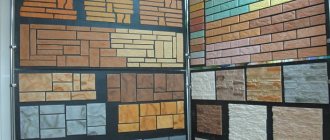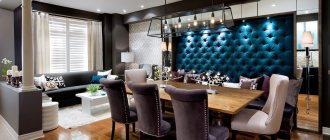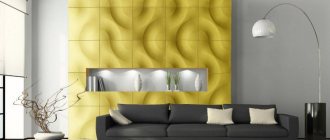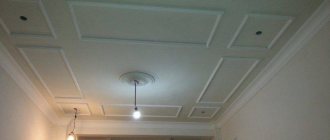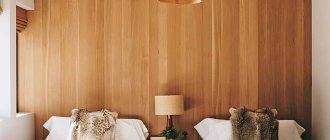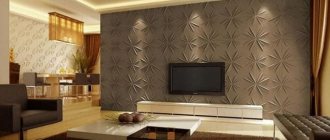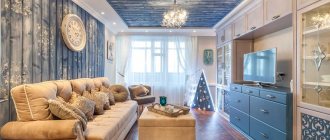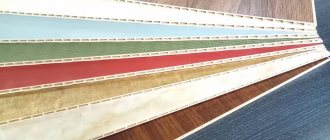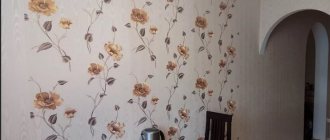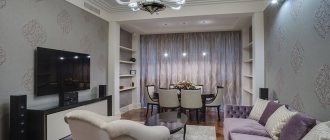The hallway, as the face of the house, should be attractive and cozy. But its main feature is cross-country ability, high humidity, and in some cases, temperature changes. Therefore, for wall decoration, you need to choose materials that combine external beauty with excellent technical characteristics. The panels, a modern finishing material, meet all these conditions. To choose the right wall panels for a corridor, you need to consider what they are, where they are best used, and what are the features of their installation.
Brick wall panels in the hallway.
Many types of this material will allow anyone to find an option that suits the style and price.
Examples of floor finishing
There are a number of requirements for the material used to finish the floor in the corridor:
- Moisture resistant.
- Resistance to chemical agents (salt and other things that are often used in winter and brought into the hallway with shoes).
- High wear resistance for long service life.
- Ability to hold heavy weight.
- It washes well and is difficult to get dirty (the grooves become clogged with dirt, and it is directly absorbed into the linoleum).
- Environmental friendliness and safety.
It is worth choosing based on external qualities. The coating should be pleasing to the eye and fit into the design.
Flooring options
To finish the floor in the corridor use:
- Linoleum - it is better to take homogeneous, painted over the entire surface, durable and non-slip.
- Quartz vinyl tiles are most often used for corridors, as they have all the necessary qualities and can last for decades. Ceramic also withstands loads well and is easy to clean, but you need to choose the option for the floor (it has increased strength).
- Natural stones - granite is the best, although it is not cheap. Marble will not last long and will quickly begin to lose its qualities under the influence of chemical agents.
- Laminate – has a service life of up to 15 years and a lot of color options. The advantage of this coating is that you can install it yourself.
- Parquet is a finicky material that requires frequent maintenance. If you have already decided to decorate the floor in the hallway with it, then choose boards made of ash, oak, birch, or beech.
Some people use carpet to finish the floor in the hallway; it is soft, beautiful, but absolutely not practical. It will need to be constantly cleaned of dirt, stains quickly eat in, and the lint can get crushed where people constantly put on their shoes. Therefore, it can only be used if putting on shoes takes place in the vestibule, otherwise it is a complete nerve-wracking experience.
Advantages of MDF panels
The hallway is rightfully considered the “face” of the entire apartment, which means that special attention should be paid to . That is why it is advisable to choose MDF panels for finishing the hallway, which have a number of advantages:
- environmental friendliness and versatility;
- absence of harmful and toxic emissions;
- attractive appearance;
- excellent heat and sound insulation;
- ease of transportation and installation;
- ease of care;
- possibility of dismantling;
- wide range of colors and variety of designs;
- resistance to mechanical stress;
- durability.
Unfortunately, like any other material, MDF panels have their drawbacks. The main one is that such walls, due to fastening to the sheathing, remain hollow. In addition, MDF panels are not able to form a perfectly smooth surface , and if you do not follow the recommended steps, then the panels may “play” over time.
A hallway with MDF panels can be truly stylish
Types of wall panels, their pros and cons
Modern technologies and many types of raw materials are actively used for the production of wall modules. Wood, bamboo stems, gypsum, cellulose, cork, leather and fabric are environmentally friendly coatings that can be recommended for use in living rooms - living room, bedroom or children's room, but polyurethane (PVC) panels are more suitable for decorating corridors, kitchens and bathrooms .
Solid wood wall panels
are highly valued for their respectable appearance, durability and excellent thermal insulation qualities. As a completely natural material, wood allows air and moisture to pass through well, providing natural ventilation and creating a healthy indoor microclimate. The only downside to this type of finishing may be the high cost, but the numerous advantages completely justify all the costs.
MDF panels
in terms of their qualities they are almost as good as boards and even surpass them, since they are more resistant to moisture and do not deform over time. However, the beautiful cut pattern in this case will not be real, but obtained by veneering, which somewhat reduces the elitism of the finish. From an environmental point of view, finely dispersed slabs are absolutely safe, as they do not contain harmful resins.
Chipboard panels
available due to low cost and a huge range of external coatings, but they evaporate harmful formaldehyde. Particle blocks are very susceptible to dampness, so in the immediate vicinity of the walls they can quickly swell and lose their aesthetics.
Fiberboard panels
thin and light, notable for their low price. If necessary, it is very easy to cut the sheet with a stationery knife, and ordinary glue will be enough to attach it to the wall. The reverse side of this material is rough; in the case of wall decoration, the front side is laminated with a film with some kind of pattern or texture. Fiberboards quickly bend and get wet when exposed to high humidity.
Gypsum panels have greater density and weight
Due to their increased fragility, they should be handled with care. The plasticity of gypsum allows you to create unusual reliefs and three-dimensional 3D effects
Heavy blocks are attached to the walls mainly with glue, since any other fastenings can simply destroy the integrity of the modules.
Bamboo panels
fit harmoniously into exotic design trends - Japanese, African, Hawaiian, although nothing prevents them from being the highlight of modern minimalism. Typically, these slabs consist of dried bamboo stalks fastened together and glued to a fabric base. The natural material comes in various thicknesses and shades, and its strength, environmental friendliness and moisture resistance make it the optimal covering for walls in any room.
Soft panels
are made in the same way as, for example, headboards. On a base made of fiberboard or plywood, padding is laid - a thin layer of foam rubber, padding polyester or felt, which is then covered with fabric or leather (sometimes leatherette).
In the interior, such solutions look unusually original and expensive. However, a soft slab usually decorates only one area in the room - the area behind the bed or the wall above the sofa in the living room. This type of decoration looks very appropriate in lounge cafes and other places for evening relaxation.
Plastic (polyurethane, vinyl, PVC) panels
- one of the most inexpensive and versatile materials for wall cladding. The simplicity of applying a picture to the front side of these plates gives enormous scope for the implementation of all design ideas. Plastic is extremely resistant to humidity, temperature changes and mechanical damage, but despite all its positive qualities, it can create a greenhouse effect in rooms, preventing normal air circulation.
Mounting to the wall: instructions
There is no need to process or prepare the surface before installation, as is the case with other facing materials. You can leave old wallpaper and other surface finishing materials. This is another advantage of MDF panels: you bought it and finished the wall. No prep work. The only thing you need to know is how the cladding itself is done.
To do everything correctly, you need to find a checkpoint. To do this, you need to determine the place that sticks out the most. This is the control point. This is where the repairs need to start. Parts are attached to it level. The slats are fastened horizontally, the maximum distance is 25 centimeters. If you increase the distance, the structure will be fragile because the panels are located vertically.
vote
Article rating
Necessary materials for the hallway
When comparing all the rooms in the apartment, the hallway occupies a special leading place.
Based on this, the types of materials for decorating the walls in the hallway are determined, which will give it some reliability, help to modify it if necessary, and increase the duration of its operation.
As for modifications, this is especially true in those houses where children or pets live, since they cause damage or possible contamination.
It is for this reason that it is better to select materials that can be easily cleaned (it is better to purchase less light shades) and, if necessary, restored.
An equally important problem is the lack of space, and this is typical even for large apartments. As a result, the space usually becomes cluttered and resembles a warehouse for storing a wide variety of items of all sizes.
Currently, there is a huge amount of a wide variety of materials for decorating walls in the hallway, characterized by strength and high quality. However, the choice must be based on compliance with a number of requirements and criteria.
Artificial stone on the walls of the hallway
Decorating the wall with stone in the hallway looks very beautiful and unusual. This material is considered environmentally friendly and as safe as possible. Artificial stone can withstand high humidity well, is quite strong and durable to use, and is easy to keep clean.
Very often, this coating is combined with decorative plaster or paint, since artificial stone is quite expensive and it is not always possible to cover all the walls of the room with it.
Bamboo wall decoration
Bamboo finishing materials are presented on the market in the form of panels and wallpaper.
Using bamboo in the interior.
The panels are made from bamboo trunks by hot pressing.
Wallpaper is bamboo slats glued to a gauze base or rice paper. The color range of wallpaper is wide; they can be plain or have a natural pattern.
Advantages:
- High strength;
- Resistance to all types of mechanical stress and contamination;
- Environmental friendliness;
- Easy installation;
- Possibility of combination.
Wall decoration using bamboo.
The disadvantage is a clear stylistic direction.
Wallpaper on the hallway walls
Decorating the walls with wallpaper in the hallway is the most popular option for any style. There are many options and designs for this material. For the hallway it is better to choose vinyl or non-woven wallpaper of good density.
You can also use liquid wallpaper, glass wallpaper and photo wallpaper. Some wallpapers are washable, making them easy to maintain and can also visually expand a space or ceiling height. Wallpaper is durable in use and most of them can hide minor defects and unevenness of the wall.
Beautiful finishing examples
Decorative PVC panels are considered the most popular among buyers today. After all, thanks to covering various surfaces with such products, you can independently create a unique look in the interior.
Bedroom
The bedroom requires soothing and relaxing shades, so in this case it is necessary to choose panels of light shades. It is not recommended to use glossy surfaces with a reflective effect. This design will only bore owners. An excellent option is to decorate the walls with panels that imitate wood.
You can also sheathe one of the walls in the room, while all attention will be drawn to it
Bathroom
If you decide to decorate the walls and ceiling with plastic products, then be careful with color schemes. It is undesirable to use more than 2 shades in a given room. It is also worth abandoning too provocative color schemes; it is better to opt for neutral tones (gray, beige, white).
In this case, choose seamless types of products so that moisture does not get inside the structure, thereby preventing the appearance of mold and mildew. In the bathroom you can use plastic tile panels in combination with natural stone. For a large room, it is possible to use sheet products that imitate mosaics.
Kitchen
Typically, owners use PVC finishing in this room in places that are subject to constant contamination (above the sink and washbasin). It is also appropriate to use zoning here. This way you can highlight the dining area in the room. If the kitchen set is made in light shades, you can use bright shades of the finishing product to dilute the boredom in the interior. When decorating the ceiling with PVC panels, you can install built-in spotlights or lighting.
See below for more details.
How to combine beautifully with other materials?
You can create a beautiful image of the hallway by combining different materials. It’s good if there is enough space in the corridor and there is room for your imagination to run wild. The panels can be combined with wallpaper, decorative plaster, paint, decorative stone, and frescoes.
It is sometimes appropriate to divide the hallway into two zones: the entrance and the vestibule. In this case, it is preferable to use different finishes for them. So, for example, a fragment at the front door can be finished with panels, and the rest with wallpaper or paint. Another design option is also possible. The owners can decorate the entrance area of the corridor with stone, and, in fact, the hallway with slatted panels.
When zoning, you can use not only different materials, but also different types of panels, for example, combining tile and sheet.
A good option for finishing one zone is a combination of wallpaper and wall panels. Especially if the hallway has high ceilings. In this case, wallpaper is usually placed on the upper part of the wall, and the lower part is covered with panels. The joint is hidden by molding. Instead of wallpaper, paint or decorative plaster can be used.
A combination of panels with frescoes is possible. For example, two or three walls are covered with panels, and on one wall a fresco is placed that fits into the interior design of the room. In the corridor, a good solution would be to make mirror inserts. They can be placed under the ceiling, above hanging shelves, if any, or in a niche.
Stone, as a decorative detail, can be used to decorate the walls in certain places on top of the panels.
It is recommended not to experiment with a combination of stone and 3D panels. You can add volume to the hallway using just one thing, but a mixture of them will reduce the space and will look too intrusive.
Panels can be used not only as the main finishing material or one of the main ones, but also simply as a decoration element. If the walls are decorated with wallpaper or paint, you can place, say, a bamboo sheet on one of them to create a Japanese style.
Don’t be afraid to try something new when decorating your hallway, but don’t forget about the boundaries dictated by your sense of taste and style.
Color options for panels in the corridor
Design involves using more than just one color. Although the color range of the material is not as diverse as that of plaster or wallpaper, there are still many options. This is especially true for budget panels - PVC, MDF, chipboard and fiberboard. Richly colored wood, such as oak, is often used in the interior. Or paneling in calm tones, such as alder. Decorating the corridor with PVC panels with wallpaper is common and is considered one of the most attractive options.
If the corridor is small, then the use of dark colors is not advisable. It is better to mount light wood species to visually expand the space. In this case, you should take into account the color of the furniture being installed. It should not be allowed to merge with the finishing material.
As for stone, you can use various shades of artificial material, ranging from light tones to dark ones. For those who have chosen the loft style, an imitation brick wall, which symbolizes asceticism, is suitable. The decoration of the non-residential area, if it does not blow away the guests, will at least make an impression on them.
Which ones are better to choose?
Before you go to choose panels for the corridor, you need to take into account several nuances. These will include the surface of the walls (flat or uneven), the need to install additional heat and sound insulation, the area of the hallway, the height of the ceiling, the general style of the living space, even the number of residents.
If the walls are uneven, it is better to use tile or slatted panels fastened to the sheathing.
Leaf varieties are suitable for smooth surfaces. When choosing, also proceed from the need to retain heat and isolate the room from sounds from the outside. Consider materials suitable for these purposes: MDF, cork, bamboo. If additional insulation is not required, the choice of materials can be expanded.
In a narrow corridor it is advisable not to use a frame. But if there is such a need, try not to choose voluminous models, especially darker shades. This way you will turn the room into a narrow room where it will be impossible to turn around. The best choice would be sheets of light colors. There may be an unobtrusive ornament.
If the hallway area allows, you don’t have to skimp on all sorts of decorative elements, which can be stone trim or 3D panels. To visually raise the ceiling, cover the walls with slatted panels vertically.
To expand the space, use the same variety, but positioned horizontally. Do not deviate from the general style of the apartment or house.
For classics, wood materials, MDF, and cork in discreet natural colors are suitable. Various carved elements and moldings will highlight the classic design. Wooden panels are also suitable for creating a country style. For the loft style, stone finishing is best suited. Moreover, it should not look elegant and expensive. The surfaces need to be given the appearance of brick walls of an older building. Plastic, if you choose the right color, will fit into a minimalist, modern or high-tech interior.
When selecting panels, consider whether you need moisture-resistant materials. If there are not many residents, dirt accumulates in the corridor in small quantities, then perhaps moisture resistance will not be a priority when choosing panels.
Advantages and disadvantages
Due to their specific properties, the panels can be used in places where other materials would suffer. For example, in a bathroom or toilet, plastic panels will fit just right. Or, if repairs need to be done, but there is no money for natural materials, plastic can also come in handy.
PVC panels look good everywhere
But in order for it to look good, not leave the walls and complement the interior, instead of completely breaking it, you need to approach the choice and placement in the house wisely and consistently.
Before we figure out what types of plastic panels there are, where they should be placed, and where it is better to use another material, let’s first look at their basic properties.
The following are useful:
- Low price. This is one of the main advantages - plastic is a cheap material that can still look good, stylish, and interesting.
- Ease. Typically, wall finishing materials are quite heavy - especially when it comes to tiles or natural wood panels - but plastic does not have this drawback. Even a child can lift one element, therefore, there will be no problems with delivery and mounting on the walls.
- Moisture resistance. One of the materials that is completely insensitive to moisture. Even the joints between the panels can be sealed so that no water gets into them.
This material has a low price
- Easy to care for. Plastic does not like aggressive chemicals, but practically no dust, dirt, or various kitchen liquids stick to it. If you don’t start it, you can simply wash off all the dirt with a cloth soaked in soapy water.
- Resistant to temperature changes. Only the cheapest plastic melts, but nothing is usually made from it in construction. Although expensive PVC panels, of course, should not be placed directly above a gas stove or fireplace.
- Soundproofing. Despite the fact that PVC is usually thin, it dampens sound quite well. Especially if you put a thin layer of insulation between it and the wall.
- Insensitivity to biological stimuli. Plastic does not mold, and the distance from it to the wall is usually so small that parasites cannot grow there, even if we are talking about cockroaches and not rats.
Brick finish
- Diversity. Plastic, like any synthetic material, is easy to paint. That’s why you can find all sorts of panels on the market - single-color and multi-color, patterned and plain, with and without patterns. They can also be made with different textures - waves, imitation wood or stone.
- Easy to install. Structural elements are usually equipped with a simple device for coupling of the “spike-lock” type. Even a person who has never undertaken a renovation in his life can put them together. No specific skills are required.
The material dampens sound well
But, of course, not a single material can have only useful properties.
There are also unpleasant ones:
- Lack of resistance to mechanical damage. Plastic is a thin, lightweight material that is easy to damage. You can scratch it even with a brush that is too hard, but a blow inflicted accidentally and casually will probably leave a crack. Therefore, both use and transportation must be careful.
- There is a high probability of buying a low-quality product. It’s difficult to mess up with natural stone, just like with wood - they won’t cost less if you violate the production technique. But plastic will, so there is always a chance of buying panels that will melt, have a very unpleasant smell, or quickly deform.
- Specific smell. Despite everything, even expensive PVC, made according to all the rules, at first emits an odor that may seem unpleasant.
- Difficulty fitting into the interior. Natural materials can be adapted in one way or another to suit any style. But PVC is suitable only for those that are democratic enough to tolerate synthetics - all these are modern styles.
Easy to install
In fact, it makes sense to install plastic panels in rooms where strength is less important than resistance to changes in temperature and humidity.
It is interesting that despite its stability, plastic cannot be placed in rooms where the humidity rises higher than seventy percent, otherwise it will quickly fail.
Fiberboards and their characteristic properties
What is the hallway room in an apartment? This room is something of a calling card. And wall decoration is generally very important - after all, thanks to such cladding you can radically transform the entire style direction. Thanks to the texture and color of a specific finishing material, the same visual image appears on the basis of which a person draws a conclusion about your hallway and its design.
Decorating the hallway with MDF panels is often done
This is why it is so important to think through the design of the walls carefully. This detail is important.
What are the advantages of the panels, why are they popular in hallway decoration
?
- First of all, installation work is easy. Any person can cope with such a task - if only they have the desire. Also, during the work there will be a minimum of dirt, dust and construction debris: which cannot be said about other cladding options.
Fixing MDF panels on the wall can be done in different ways. Due to this, you will always be able to choose the solution that will be the most suitable for your home.
- Another advantage of the panels that you should pay attention to: the strips are cut very simply - a jigsaw or hacksaw will help with this. And if you need to replace one or another part that is damaged: there will be no difficulties with disconnection - the elements come off the base easily, immediately;
- There are also other advantages: the sound insulation in the room will be good, as will the thermal insulation. There will simply be free space between the walls and slabs. Insulation is placed here, and any communications can be hidden here without any problems.
Rules for choosing wall panels for a corridor
The main criterion that you need to familiarize yourself with before choosing wall panels is the properties and features of their materials. Modern wall panels are most often made of MDF, plastic, natural wood, chipboard, fiberboard, cork, mineral wool and polystyrene with mirror filling.
To decorate the corridor, you can use any type of panels, but please note that if the front side of the finish is additionally covered with a layer of wax or laminate, then they belong to the class of moisture-resistant finishing materials. Since high humidity is rarely observed in corridors, there is no need to make special requirements for their moisture resistance
Each material used to make panels differs not only in its design, but also in its technical characteristics.
MDF
For example, MDF panels are highly durable. This material can improve the sound and heat insulation properties of a room. However, when choosing MDF panels for finishing a corridor, keep in mind that if they are used at elevated temperatures, the material may expand, losing its attractive appearance.
Decorating the corridor with wall panels
Plastic
Plastic panels also improve the sound insulation of the room. The finishes made from this material are attractive for their design variety: they can be glossy, matte or cellular. In addition, they are often covered with drawings and patterns. Plastic panels in the hallway are also good because they are very easy to care for. Since the material is not afraid of moisture, it is enough to simply wash it to remove dirt. The only disadvantage of plastic panels is that they are a completely unnatural material.
Plastic panels in the corridor photo
Tree
Wood panels are perhaps the leaders in the list of the most attractive finishing materials. Wall panels made of natural wood enhance the interior of the corridor, giving it a solid and rich look. However, this material requires some design unity, and besides, natural wood is expensive.
Wooden wall panels for corridor
Panels in the corridor photo
Chipboard and fibreboard
Panels made from chipboard and fibreboard, on the contrary, are attractive due to their affordable price. This material is ideal in cases where the most simple and unobtrusive design is required. However, keep in mind that chipboard and fiberboard materials are not durable.
Corridor Wall Panels
Cork
Cork panels have all the characteristics necessary for comfortable use. This material is durable, natural, lightweight, it increases the heat and sound insulation of the room. In addition, cork wall panels have a stylish design. Their cellular structure can decorate any interior, especially an entrance hall or corridor.
Cork panels for walls in the corridor photo
Decorating the corridor with cork wall panels
Mineral wool
Mineral wool panels are usually used in rooms where it is necessary to create certain acoustic conditions or on the outside of the building (sandwich panels). However, if this material is treated with an additional coating, it can be used to decorate the walls of an ordinary hallway.
Mineral wool for filling wall panels
Mineral wool panels for external walls
Mirror polystyrene
Mirror polystyrene panels are attractive with their design. For their production, a film that imitates a mirror coating is used. As a rule, panels of this type are best used as additional finishing material. In addition, polystyrene has good flexibility. Wall panels made from it are ideal for decorating walls of non-standard shapes, niches, ledges, columns, etc.
Mirror wall panels in the hallway photo
Mirror panels made of polystyrene
Wall design options
The panels are used to decorate interiors in various styles. Their colors and design options are varied. With their help, you can hide all the shortcomings of the room and highlight its advantages.
Light shade options are ideal for poorly lit rooms . They are able to visually enlarge the space and make it warmer and brighter. Moreover, a tandem of light panels and a dark floor covering will look good. The interior decoration of the hallway in dark colors requires the use of panels in the same color scheme. Such a room will look elegant and deep.
However, such an interior requires good lighting.
An interesting idea would be to use options with small patterns or designs. Panels in minimalism or loft style look very stylish. They have a simple but interesting design. But large patterns and prints are best suited for spacious hallways. They attract too much attention and will negatively affect the appearance of small rooms.
Glossy shiny and mirrored models make the space wider and more spacious. They are well suited for decorating narrow and long rooms. Vertical slats are suitable for rooms with low ceilings, but horizontal slats are suitable for narrow rooms.
For a classic style, it is better to use models with an unusual design. The panels can be decorated with stucco, moldings, cornices and other decorative elements. Panels with relief will help create a bright accent in the interior.
You can line the walls with natural stone or its imitation; this solution will ideally complement an interior in a country, loft, Provence or classic . Wooden wall panels will fit perfectly into a rustic or classic interior. Wood texture looks better on dark shades. The walls covered with colored glossy panels look beautiful.
They will make the room brighter and more stylish.
A variety of decorative wall panels with photos
The panels vary in shape, have characteristic properties, are used in a particular room, and perform certain functions. The forms are divided into three groups.
- Slatted panels are long planks, for the production of which PVC, fiberboard, chipboard, and MDF are used. They are often mounted in rooms with many corners, in small rooms. Light panels can visually adjust the space of a small room (kitchen, bathroom, hallway, balcony). The horizontal arrangement of the planks will elongate the walls, and the vertical arrangement will visually raise the ceiling of the room. Wall panels of this shape are easy to install; they are attached with staples or screws to aluminum or wooden sheathing.
- Tile panels are square in shape from 30 cm to 1 m. They are fastened using steel plates for fastening or glue. If you arrange wall panels on a plane in different ways, you will get interesting options for wall decoration. By arranging the slabs at different angles and at several levels, you can get an original design for the interior of the room. The final touch will be the built-in lighting between the levels.
- Sheet wall panels are the largest in size (1.22 by 2.44 m, thickness - 3 cm), most often made of PVC and fiberboard. They form a multi-level structure with an applied pattern, texture that imitates other finishing materials (wood, stone, brick) or a combination thereof. The panels are attached with glue, and the seams formed between them are filled with moldings.
| Kinds | Material | Advantages | Flaws |
| Wooden panels | Oak, cedar, maple, alder, walnut, pine | Eco-friendly material; Improves the interior; Combines with other facing materials | They do not tolerate moisture; High price |
| MDF panels | Wood waste compressed under high temperature | They have sound and heat insulating properties; Can be made moisture-resistant, fire-resistant; Easy to care for | Not recommended for use in the kitchen or bathroom |
| Fiberboard panels | Wood fibers compressed at a temperature of 180-200 C | Wide range of colors and textures | Low moisture resistance |
| Chipboard panels | Sawdust and shavings impregnated with formaldehyde resins | Big choice panels covered with veneer, plastic | Harmful to humans and the environment; Cannot tolerate high humidity; Difficulties during installation |
| Bamboo panels | Bamboo tess | Easy to install; Withstands changes in humidity; Vapor permeable; Universal; Acceptable price | Cannot withstand severe mechanical damage |
| Gypsum vinyl panels | Vinyl coated drywall | Strong, durable; Combines with other finishing materials | Insufficiently moisture resistant; Not all products are suitable for cleaning |
| Glass panels | Strained glass | Resistant to external natural influences and moisture; Serve as a solid basis for creating drawings | Do not clean with products containing abrasives; Difficulty in cleaning the surface in the form of streaks and stains; Exposure to direct sunlight will damage the pattern on the panels over time |
| Stone veneer | cut stone | Environmentally friendly and safe material; Durable and reliable; Adapts to any surface shape | High price |
| Soft panels | Leather, textiles | Easy to care for; Resistance to moisture, sunlight and temperature changes; Soundproofing | Frequent cleaning required; For any damage, the entire panel is replaced |
The following types of panels deserve special attention. Some of them appeared relatively recently and differ from previous ones in their originality and creativity.
Modern room design with wall panel
Apartment interior with wall panel
Original room design using wall panels
Interesting interior design ideas
Most often, homeowners do hallway renovations last, but this approach is wrong. The hallway is visible from all rooms of the apartment, and neighbors can accidentally see it from the landing, for example.
Upholstering the entire wall with panels is possible when you intend to emphasize your position. In this case, coffered models made of solid wood are used to decorate the ceilings and walls. Of course, such a classic approach is considered too heavy for contemplation, especially in small and low rooms, but for classical design styles it’s just right.
Using wall panels only to decorate a certain part of the wall provides many advantages. There is no need to measure the height of the ceilings and select furniture or interior items according to certain sizes. The decorated area will not clutter up the space of your room.
The combination of airy white and cream color gives inspired lightness and grace to the space. Decorative elements bring a qualitatively new sophistication to the interior and emphasize the excellent taste of the owners.
The use of panels on the lower part of the wall is practical and aesthetic. A single-color solution with an entrance door adds a touch of solidity and wealth to the simplicity of execution.
In a private house, we are more often faced with spacious hallways and corridors, well lit. Sometimes they include a staircase to the second floor, which gives even more room for creativity. The richness and restraint of this room attracts with its laconicism and distinct lines.
To summarize, all that remains is to add the well-known saying “measure twice, cut once” - having thought through the interior decoration of the hallway to the smallest detail, you will never be disappointed with the result. Good luck with the renovation!
To learn how to make repairs in the hallway of a Khrushchev building, see the following video.
Kinds
Depending on the parameters, polyvinyl chloride slats come in several varieties.
Tiled
The tile material is similar in appearance to ceramic tiles. The standard dimensions of this product are 30x30 cm, 98x98 cm, 100 x 100 cm. Their thickness varies from 1 to 5 mm. Tile panels can be used in combination with plain variations of tiles that imitate natural stone.
Wall
Wall slats are used to decorate wall surfaces. Thanks to the large range of products, it becomes possible to create an original image in the interior of the room. The width of the products varies from 15 to 50 cm, size - 2.6 m, 2.7 m, 3 m, thickness - from 6 to 10 mm.
Leafy
These panels differ from previous variations in large parameters. When working with this type of product, a large working surface area is covered. The standard width of the lamellas is 50-122 cm, size - 0.9 -2.44 meters, thickness - 1-6 millimeters.
Sheet products often imitate various materials:
- tree;
- brick;
- mosaic;
- tile.
Lining
This type of plastic product has a polished surface. Manufacturers produce lining in various colors and textures. The connection of the products is carried out using the existing spikes, as a result of which even an inexperienced craftsman can perform the installation. Product width – 10-30 cm, size – 90 cm – 3 m, thickness – from 4 to 8 mm.
PVC lining is manufactured in 2 variations:
- “Eurolining” is a product of a standardized size with a wide locking design. Width – 10 cm, width – 3 m.
- “Polka” is a product of a standardized size with a narrow locking system. Length - 3 meters, width -10 cm.
PVC wall panels also differ in connection method:
- lamellas with relief coating;
- seamless plastic building materials;
- panels that are chamfered.
Seamless finishing building materials are usually used for ceiling cladding in various rooms. With proper installation, you can achieve an effect in which the joint between the parts will be almost invisible. The seamless joining method allows you to create continuous lines and patterns when covering various surfaces.
Panels with a chamfer are somewhat reminiscent of seamless products. The only difference is that in the first option there is a chamfer in the end part of the building material. A chamfer is a recess designed to connect plastic panels into a single whole.
Lamels with a relief surface are usually used for finishing wall surfaces. In appearance they are similar to lining. Relief products differ from previous variations in their high strength coefficient and wear resistance. Due to such technical characteristics, they have a high cost.
With 3D effect
This type of product is used not only in the design of residential buildings and apartments, but also in office buildings and shops. The original drawing allows you to create a unique design in the room. Lamels with this effect imitate natural wood, natural stones, and ceramic tiles. Standard parameters: width – 25 cm, 37 cm, 50 cm, size – 2.7 m, 3 m, thickness – from 8 to 10 mm.
With thermal transfer
The technology for manufacturing this type of product is carried out in such a way that an image or pattern is displayed on a polymer film, after which, using specialized equipment, this image is transferred to a plastic building material under the influence of high temperatures. Panels with thermal transfer are considered the most popular among homeowners, because they have a high resistance to high temperatures, and installation is not difficult even for a novice builder. The width of the panels is 25 centimeters, the size is 2.7, 3 and 6 meters, the thickness is from 8 to 10 mm.
Laminated products
The method of manufacturing laminated panels is that a film with an image and decoration is glued to the front part. This manufacturing method gives the finishing material additional performance characteristics; such a pattern or image is quite difficult to spoil. Laminated panels are treated with an antiseptic agent, which prevents small particles of dust from settling on the surface of the products. The quality of panels of this type is certified by an appropriate quality certificate. Width – 25 centimeters, size – 2.7 and 3 m, thickness – from 8 to 12 mm.
(no votes yet)
Hallway wall panels: surface preparation
Before you begin to attach the finishing material, the hallway walls must be prepared. The first important step will be the removal of old material, wallpaper and plaster. The next step will be to level all uneven wall surfaces; this should only be done if not lining or laminate is used.
An important detail needs to be taken into account. If the hallway is small, then it is better to refuse frame installation, as this will significantly reduce the size of the corridor.
If the choice fell on finishing with wallpaper, stone or decorative plaster, then make sure in advance that all the walls are perfectly smooth. After the work has been done, we sheathe the walls of the hallway.
Preparing for work
Having decided to decorate your hallway with MDF panels yourself, you should worry in advance about stocking up on the required amount of materials. You should calculate the surface area that you are going to cover with MDF in order to calculate the number of panels required for the job.
In this case, the decisive factor when calculating the number of panels will be the width of the area to be covered with panels.
Calculation of the required number of panels should be made taking into account their width. The most common standard width is 15 cm, but panels are available in 19 or 24 cm widths.
To calculate the required amount of MDF per wall, you need to divide the width of the wall by the width of the type of panels you have chosen. Based on this, you will determine the amount of MDF that you should stock up on before starting work. Please note that panels should be purchased with a small margin in case of an error or unexpected defect. In addition to the panels, you will also need special moldings.
Before covering the walls with panels, pre-treat the surfaces in the hallway with special disinfectant compounds. This will allow you to avoid the appearance of mold or mildew in problem areas of the wall in the future.
Important: preliminary preparation of walls for MDF cladding does not require puttying and plastering of the walls or cleaning them of old paint. You just need to remove the old baseboards from the floor.
